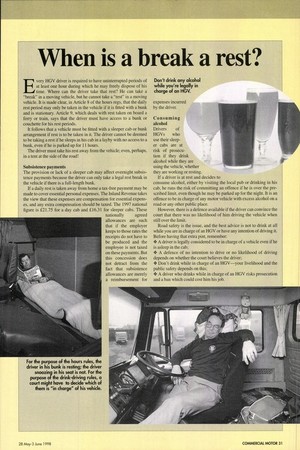When is a break a rest?
Page 33

If you've noticed an error in this article please click here to report it so we can fix it.
Every HGV driver is required to have uninterrupted periods of at least one hour during which he may freely dispose of his time. Where can the driver take that rest? He can take a "break" in a moving vehicle, but he cannot take a "rest" in a moving vehicle. It is made clear, in Article 8 of the hours regs, that the daily rest period may only be taken in the vehicle if it is fitted with a bunk and is stationary. Article 9, which deals with rest taken on board a ferry or train, says that the driver must have access to a bunk or couchette for his rest periods.
It follows that a vehicle must be fitted with a sleeper cab or bunk arrangement if rest is to be taken in it. The driver cannot be deemed to be taking a rest if he sleeps in his cab in a layby with no access to a bunk, even if he is parked up for 11 hours.
The driver must take his rest away from the vehicle; even, perhaps, in a tent at the side of the road!
Subsistence payments The provision or lack of a sleeper cab may affect overnight subsistence payments because the driver can only take a legal rest break in the vehicle if there is a full-length bunk.
If a daily rest is taken away from home a tax-free payment may be made to cover essential personal expenses. The Inland Revenue takes the view that these expenses are compensation for essential expenses, and any extra compensation should be taxed. The 1997 national figure is £21.75 for a day cab and £16.31 for sleeper cabs. These nationally agreed allowances are such that if the employer keeps to those rates the receipts do not have to be produced and the employee is not taxed on these payments. But this concession does not detract from the fact that subsistence allowances are merely a reimbursement for expenses incurred by the driver.
Consuming alcohol Drivers of HGV s who use their sleeper cabs are at risk of prosecu tion if they drink alcohol while they are using the vehicle, whether they are working or resting.
If a driver is at rest and decides to consume alcohol, either by visiting the local pub or drinking in his cab, he runs the risk of committing an offence if he is over the prescribed limit, even though he may be parked up for the night. It is an offence to be in charge of any motor vehicle with excess alcohol on a road or any other public place.
However, there is a defence available if the driver can convince the court that there was no likelihood of him driving the vehicle when still over the limit.
Road safety is the issue, and the best advice is not to drink at all while you are in charge of an HGV or have any intention of driving it. Before having that extra pint, remember: +A driver is legally considered to be in charge of a vehicle even if he is asleep in the cab; + A defence of no intention to drive or no likelihood of driving depends on whether the court believes the driver; + Don't drink while in charge of an HGV—your livelihood and the public safety depends on this; + A driver who drinks while in charge of an HGV risks prosecution and a ban which could cost him his job.






















































































































